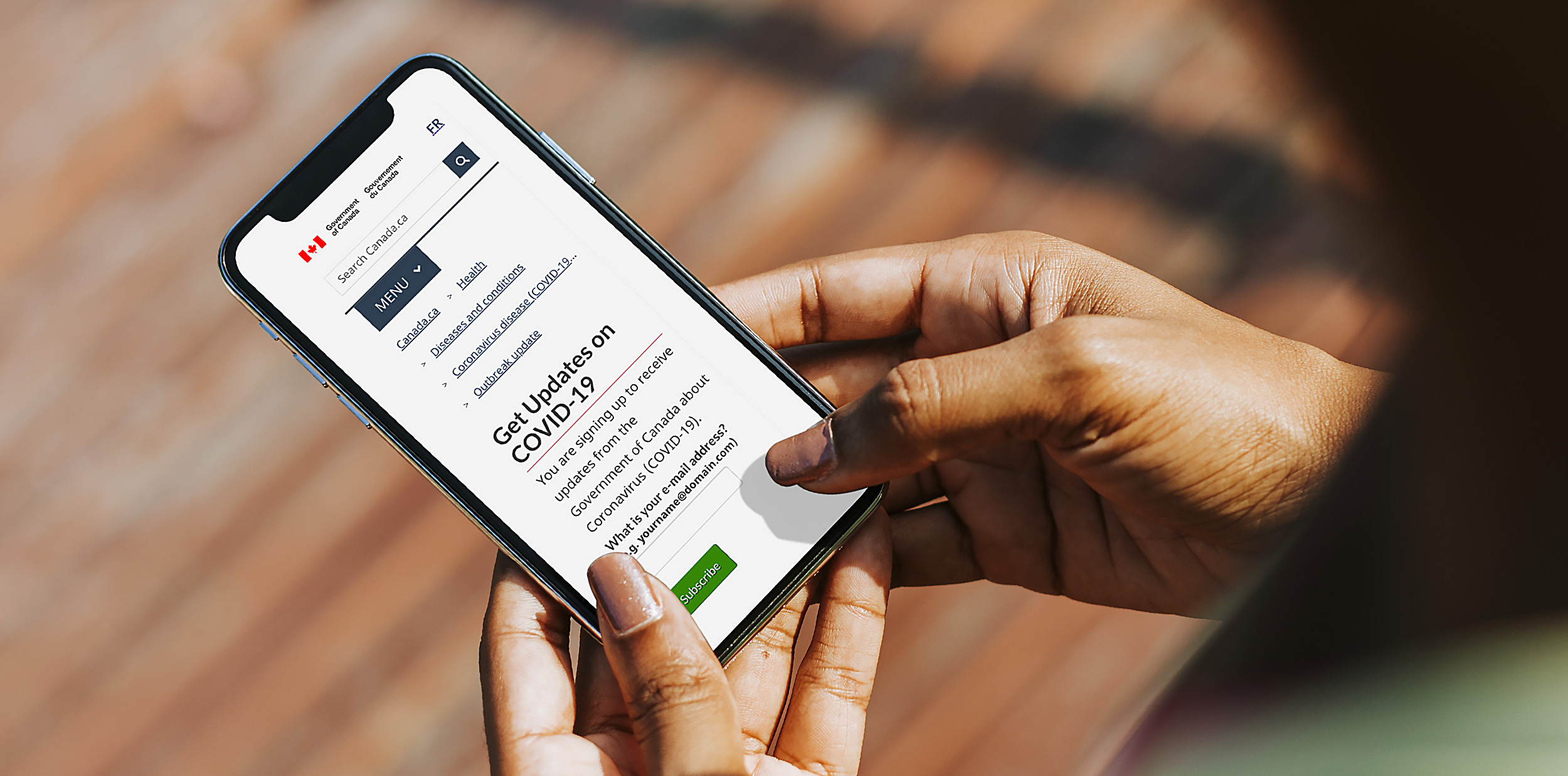
Where we started: Breaking through the noise
Three years ago, in the early days of the pandemic, disinformation was rampant. For someone scrolling through their social media feeds, it could be difficult to find credible, clear information in a world of uncertainty and confusion.
In March 2020, the need to inform and educate the public about the reality of COVID-19 quickly became apparent, so Health Canada, Service Canada, the Canadian Digital Service, and the Treasury Board of Canada Secretariat set up the “Get updates on COVID-19” service using GC Notify. Using a tool like GC Notify, instead of a custom-made solution, allowed the team to get the service up and running quickly, and saved both time and money.
For over three years now, we’ve been using data to write helpful content for the “Get Updates on COVID-19” email notification service. Data insights from the public have guided us in providing information people in Canada are looking for about the virus, its effects, public health measures, vaccines and treatment. In the height of the pandemic, we hit a peak of 58,469 confirmed subscribers, and have sent over 10 million email notifications, driving more than 400,000 visits to canada.ca from people looking for trusted information.

Infographic showcasing “Get updates on Covid- 19 milestones”. Milestones featured: 58,000 confirmed subscribers, 10 million email notifications, 3 years of service, 22,000 clicks on ‘How to book a Covid-19 vaccine appointment’ over two weeks, 400,000 canada.ca visits from email notifications.
In this post, we’ll share what we learned writing content for this service during the pandemic, and how we used the Government of Canada (GC)’s Digital Standards to continuously improve our messaging.
What we’ve learned: Using the digital standards to create useful content
When we were building “Get Updates on COVID-19”, the team took the GC Digital Standards to heart, and have embedded them in every aspect of this product. The service itself is also an example of how the government can provide better services enabled by data, as highlighted in the Government of Canada’s Digital Ambition.
But what does that all mean? Below are some examples of what the team has done to ensure we consistently send out messages that are easy to understand, timely, and applicable for our subscribers.
Analyzing data to improve our content
In keeping with the GC Digital Standards of ‘being good data stewards’ and ‘iterating and improving frequently’, the content for our “Get Updates on COVID-19” messages is developed using an evidence-based approach. With help from the data insights team, we regularly review reports on top search-terms, social media trends, inquiries to the Government of Canada’s toll-free COVID-19 information line, and visits to Canada.ca to tailor our messaging to ensure we’re providing information that’s useful.
Since our last post on using data to meet people’s needs, here’s another way we’ve iterated on our messaging:
- Based on observations of subscriber behaviour (click throughs, etc), we’ve adjusted the frequency of our messaging. Emails were sent daily at the outset, then weekly, then biweekly, and now we prioritize only sending emails as new information or situations emerge.
Using GC Notify- how an open source tool helped us save time and money
In developing this service, the team prioritized using open standards and solutions. GC Notify was adapted from existing code originally developed by the United Kingdom’s Government Digital Service (GDS), and has been regularly improved based on user needs. Using a platform tool like GC Notify helped our team get a prototype of the service up and running in two weeks, and we had peace of mind knowing the service had been built with accessibility, privacy, and security at its core.
Getting by with a little help from friends
Running this service for the past three years has definitely been a team effort, and collaboration was a cornerstone of our success. We’re grateful for the support of the folks at CDS, the Office of the Chief Information Officer at TBS, and Service Canada who allowed us to leverage their existing infrastructure to securely manage our data and subscribers’ list.
What’s next
In writing about the launch of the service back in 2020, Health Canada’s Assistant Deputy Minister Marcel Saulnier reflected on its lasting impact, saying,
“The service was envisioned specifically for the COVID-19 crisis. But the product we’ve built, with the improvements and new applications of the existing tools, can be replicated at scale. A detailed account of the product process, including links to the open source tools we used will be available for the next group building a similar email subscription-based service.”
While restrictions have lifted across the country, the pandemic is not yet over. Our team will continue to use data to learn what our subscribers would find helpful and provide timely, useful, information. We encourage people across Canada to maintain individual public health measures, such as staying up to date with your COVID-19 vaccinations, staying home when sick or infected, and consulting travel advice and health notices before travelling.
If you’re a team interested in building a similar email subscription-based service, don’t hesitate to get in touch! We’d love to share more about what we’ve learned providing evidence-based, easy to understand information to people across Canada.